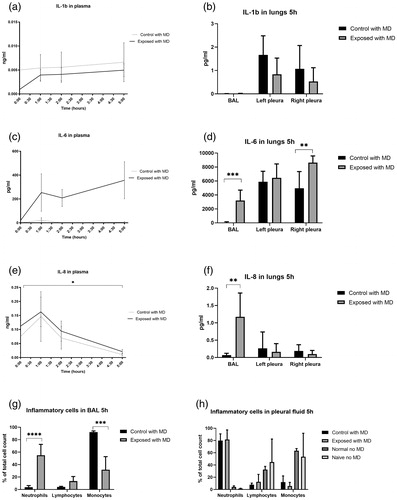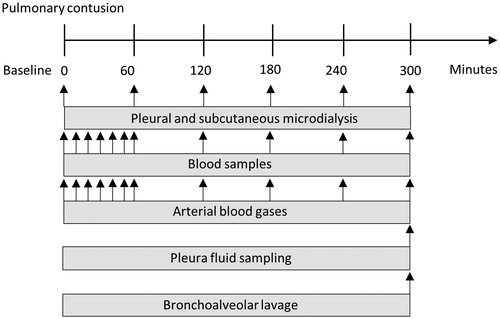Figures & data
Figure 1. Schematic overview of experimental setup with placement of pleural and subcutaneous microdialysis catheters.

Figure 2. Photos showing (a) placement of catheter in the pleura by loss-of-resistance technique with a syringe filled with NaCl. (b) microdialysis pump. (c) skin with laceration at the point of impact, with a microdialysis (MD) catheter placed at a 50 mm distance. (d) autopsy of lungs showing the contusion with hepatized lung tissue.

Figure 4. Focally severe pulmonary contusion causes ventilatory complications. (a) pO2 and (b) PaO2/FiO2 decreased after impact, while normo-ventilation was maintained, confirmed by (c) pCO2. As a result, (d) SvO2 decreased. (e) Tidal volumes were below 6 mL/kg, and adequate minute ventilation was achieved by (f) spontaneous regulation of the respiratory rate. *p<.05, ***p<.005.

Figure 5. Microdialysis of the pleura and subcutis, and plasma tests. (a-c) pleura lactate increased after trauma in the right pleura, and in plasma. (d-e) pleura and subcutis pyruvate did not differ between groups. (f-g) pleura and subcutis lactate/pyruvate ratio increased after trauma in the right pleura. (h-j) pleura glucose did not differ between groups. Subcutis glucose and plasma glucose increased after trauma. (k-i) pleura and subcutis glycerol increased after trauma in both the ipsilateral and contralateral pleura, although not reaching statistical significance. *p<.05.

Figure 6. Focally severe pulmonary contusion caused a detectable inflammatory response. IL-1b in (a) plasma and (b) pleura fluid and bronchoalveolar lavage (BAL). IL-6 in (c) plasma and (d) pleura fluid and BAL. IL-8 in (e) plasma and (f) pleura fluid and BAL. (g) inflammatory cells in BAL and (h) pleural fluid after 5 hours. *p<.05, **p<.01, ***p<.005, ****p<.001.


